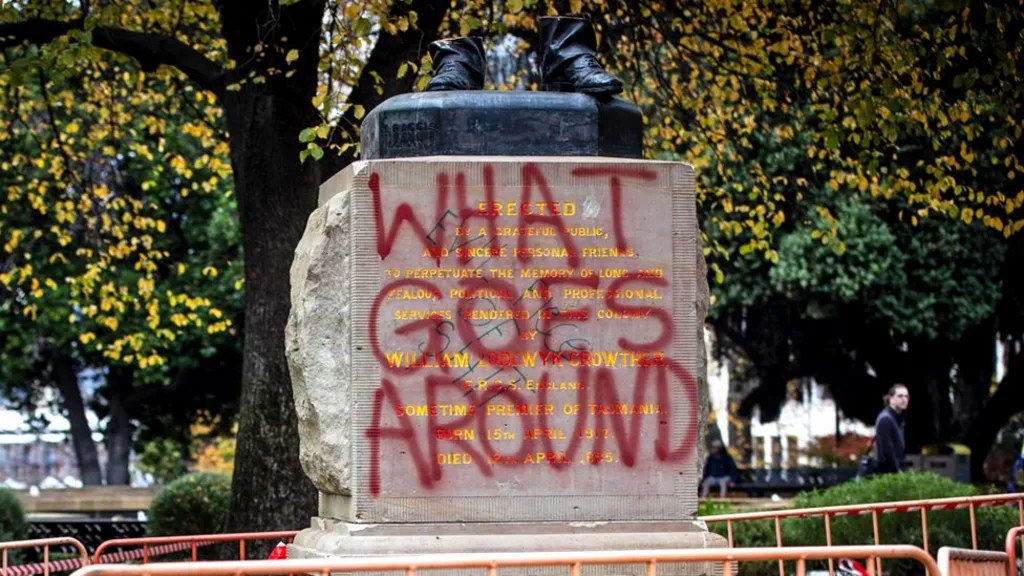Hobart, Tasmania’s serene capital, has found itself at the center of a heated debate. The reason? A bronze statue of William Crowther, a prominent surgeon and politician from the 19th century, was chopped down at the ankles in May, leaving only two bronze feet behind. The act of vandalism, while dramatic, points to a deeper issue—how Australia reckons with its dark colonial past.
Thank you for reading this post, don’t forget to subscribe!Who Was William Crowther?
William Crowther was a surgeon and Tasmania’s premier for a brief period. But Crowther isn’t just remembered for his role in public service. He’s linked to an incident involving the mutilation of Aboriginal remains, specifically those of William Lanne, a Palawa man often referred to as the “last Tasmanian Aboriginal man”—a highly contested and problematic label . Crowther allegedly stole Lanne’s skull from a morgue to further pseudo-scientific racial theories. Although he denied the charges, this act became symbolic of the brutal colonial practices towards Tasmania’s First Nations people .
A Divisive Monument
For over a century, Crowther’s statue stood in Franklin Square, and while it may have seemed like just another statue, it represented something far more sinister for Tasmanian Aboriginal people. The statue was viewed as a symbol of colonial violence, dehumanization, and the attempted erasure of Aboriginal culture. Aboriginal activists like Nala Mansell point out that the statue, for them, glorified a man responsible for a deeply painful chapter in their history (Space.com).
On the flip side, there are those who argue that Crowther’s statue is part of Tasmania’s historical fabric, representing an era, good or bad, that shaped the state. Jeff Briscoe, one of the statue’s defenders, acknowledges Crowther’s involvement in the body theft but insists the statue has significant heritage value, as it was the only monument funded entirely by public money.
The Statue Falls
While Hobart’s city council voted to remove the statue in 2022, the community grew tired of waiting, and in May, a group of vandals took matters into their own hands, severing the statue at the ankles. This left two lonely bronze feet standing in Franklin Square, a strangely poetic reminder of Hobart’s ongoing struggles with its past.
For Aboriginal people like Nala Mansell and Nunami Sculthorpe-Green, this act of destruction signaled a small victory in their larger fight to have First Nations histories recognized and respected. The mutilated statue, they argue, speaks louder than the intact figure ever did.
Reconciliation and Truth-Telling
The Crowther statue debate reflects the broader struggle Australia faces with truth-telling about its colonial past. Many Aboriginal activists believe it’s time for the country to confront its history honestly, acknowledging the genocidal violence that occurred and making room for Aboriginal voices in the national narrative .
However, others see this process as divisive. Conservative voices in Australia argue that constantly rehashing the past does more harm than good. They believe that the removal of statues like Crowther’s could be a slippery slope leading to the erasure of history altogether .
What’s Next?
The severed statue may be gone, but the conversation around it is far from over. Hobart’s council is still figuring out what to do with the statue and the now-empty plinth. Some suggest leaving the severed feet as they are—a symbolic reminder of how the city is starting to confront its past.
The legacy of William Crowther, and what happened to William Lanne, will continue to be discussed, and Hobart will have to find a way to balance the need for truth-telling with its historical landmarks. As Nunami Sculthorpe-Green aptly puts it, “We, as the public, learned, grew, and changed the narrative of this place. Look here, we cut that down”.
The removal of the statue may mark a turning point in how Hobart, and perhaps Australia as a whole, addresses its colonial legacy.

